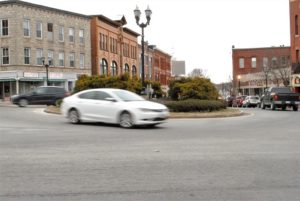By Dakota Antelman, Contributing Writer

Hudson – Selectmen voted unanimously Feb. 5 to join local business leaders in requesting the state government pay $500,000 for a redesign of Hudson’s downtown rotary.
The redesign aims to improve the efficiency and safety of the downtown area. With local businesses supporting the project, the Hudson Business Association and the Assabet Valley Chamber of Commerce both filed letters requesting state funding for it, Executive Assistant Tom Moses said. The Hudson Business Improvement District also filed a similar letter, according to its District Administrator Richard Braga.
“We are very interested in seeing [the money]…released so that the reconstruction of the downtown rotary can actually happen,” Braga said. “It’s an attractive area. And the newer design will make it all that much more attractive, pedestrian friendly, and much safer for both pedestrians and the motoring public.”
The requests target the 2016 Economic Development Bond Bill, which appropriated roughly $1 billion for infrastructure and other projects to stimulate local economies. Since its signing into law, the bill has funded projects across the state.
Hudson’s leaders have allies in requesting money from that bill especially after a December 2017 article in the MetroWest Daily News quoted State Senator Jamie Eldridge (D-Acton) publicly asking the state to fund the project.
“I continue to be committed to getting the Baker-Polito administration to release $500,000 in bond funds to begin making the Hudson rotary project a reality and keep Hudson on the move,” he told the paper.
State Representative Kate Hogan (D-Stow), Braga said, has also been supportive of the rotary project.
The redesign itself improves pedestrian crossings and more clearly marks driving lanes within the rotary. Those measures, officials and business owners hope, will safely increase vehicle and pedestrian traffic through the downtown area, helping businesses there.
Though Braga understands the potential impact of such a construction project on traffic flow through the downtown area, he downplayed the project’s effect on businesses bottom lines.
“Clearly any construction in that area creates certain difficulties for the motoring public,” he said. “But I suspect that [the town will] have a workable plan and, at the end of the day, it will be positive for everybody.”
With requests for additional state funding signed and sent, Hudson is now waiting for the state’s approval and release of the money before they proceed with the redesign.






